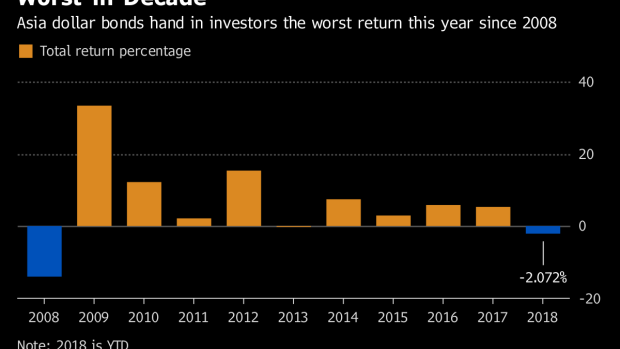(Bloomberg) -- After a blockbuster 2017, the stars seemed aligned for another strong year for Asia’s dollar-bond market in 2018. Then the trade-war and a record spate of Chinese defaults intervened, contributing to the worst sell-off in a decade.
JPMorgan Chase & Co. and Bank of America Corp. were among those at the start of the year anticipating lower premiums for corporate debt, amid a solid global economic outlook and continued historically low interest rates. Sharper-than-expected hits from Federal Reserve tightening and China’s deleveraging campaign, along with the blow to sentiment from trade tensions, sent spreads surging 109 basis points to the highest in about three years.
“Rising U.S. rates, weakness in the RMB versus the dollar, EM concerns spilling over and trade war tensions all contributed to this shift in investor sentiment” for Asian high-yield bonds, Goldman Sachs Group Inc. strategists including Kenneth Ho wrote in their 2019 outlook. “We view the key reasons for the underperformance are tighter credit conditions in China and rising onshore defaults.”
Asia’s investment-grade bonds handed investors a 1.4 percent loss since the start of the year. That left even Goldman’s forecast of a zero percent return looking too optimistic.
The asset class is just one of countless that are heading for a down year, with the broadest losses in more than a century by one measure. Some 89 percent of assets have handed investor losses, Deutsche Bank AG calculated last month.
Record local defaults in China, induced by a crackdown on shadow financing, sent overseas investors running for cover as well. A jump of more than 40 basis points in the benchmark 10-year U.S. Treasury yield this year has also hurt returns.
Here is a look at what major banks had expected for Asian dollar bonds in 2018 and how they actually performed.
JPMorgan
- Forecast a 15 basis points overall credit spread tightening to 212 basis points in 2018, with 25 basis points of spread narrowing in high grade and 37 basis points of widening in high yield; expected a total return of 4 percent
- What happened: Overall spreads widened 109 basis points this year to 282 basis points as of Tuesday, with 54 basis points of widening in high-grade and 319 basis points widening in high yield; total return has been a negative 2.1 percent, according to ICE BofAML indexes
- A JPMorgan strategist wasn’t immediately available for comment
UBS Group AG
- Expected total return of 1.3 percent for high grade and 5.1 percent for high yield
- What happened: Asian investment-grade bonds handed investors a 1.4 percent loss while junk is down 4.9 percent
- A UBS representative declined to comment
BofAML
- Preferred B rated securities to BB in Asia, liked China industrial credits and high-beta B property
- What happened: B rated Asian dollar bonds saw a 5.7 percent loss, while BB rated names lost 3.3 percent. Chinese high-yield real estate credits were down 4.7 percent, according to ICE BofAML indexes
- The bank declined specific comment on its original 2018 call, while noting that revisions were made during 2018
Goldman Sachs
- China property high yield was the bank’s top pick, seen generating the highest total return in 2018
- What happened: The sector saw a loss of 4.7 percent, worse than the negative 2.1 percent return on overall Asian dollar bonds, according to ICE BofAML indexes
- According to a Goldman Sachs spokesperson, the bank’s analysts said in a report late last year that China property high-yield would be a top pick in 2018 due to “relative value opportunities” at that time
(Updates with spread increase in second paragraph.)
To contact the reporter on this story: Carrie Hong in Hong Kong at chong61@bloomberg.net
To contact the editors responsible for this story: Neha D'silva at ndsilva1@bloomberg.net, Lianting Tu, Christopher Anstey
©2018 Bloomberg L.P.



